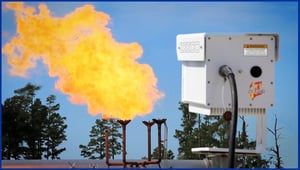New Direct Flame Monitoring Technology
CATEGORIES:
The changing government regulations imposed on refineries, gas processing facilities, petrochemical manufacturers, and OEM vendors demand constant adaptation to meet requirements. Across the globe, facilities are scrutinized for their emissions contributions to our global environment and are soon to be held to even more stringent standards. Since its inception, the United States Environmental Protection Agency (EPA) has been actively involved in various flare system enforcement initiatives to reduce the emissions from flares.
Abstract
Known shortcomings of current flare monitoring methods plus new EPA standards drove the need to develop a new direct flare combustion efficiency (CE) measurement and monitoring method – a technology that directly, autonomously, and continuously monitors flare performance in real time. This patented method, known as VISR, or Video Imaging Spectro-Radiometry, utilizes a multi-spectral infrared (IR) imager to simultaneously measure the relative concentrations of combustion products, carbon dioxide (CO2), and unburned hydrocarbons (HC) at the pixel level. Directly monitoring flare CE eliminates inaccuracies associated with the current practice of monitoring indirect parameters (heating value, velocity, etc.). Because VISR devices can operate autonomously, no aiming or manual data reduction is required. Remote measurement removes the need for contact with corrosive process streams, making VISR devices less costly to maintain and operate over time. This paper will discuss the VISR technology and how it can be used to generate continuous, real-time data on CE and smoke, allowing operators to optimize flare performance in real time.

FlareGuardianTM
To take full advantage of the advancements made by VISR technology, Zeeco has produced a VISR-based product called FlareGuardian to meet the demand for an efficient, accurate, and compliant direct flare monitoring system.
Discussion
Current measurement methods possess certain pitfalls, such as high capital cost, extensive servicing of all components, constant re-calibration of devices, exposure to corrosive process conditions, and higher labor investment to ensure compliance with mandated regulations. Also, since the EPA RTR rule is accompanied by time-dependent monitoring constraints, a problem is created when striving to comply while using methods that do not provide real-time results. Surrogate parameter measurement is dependent on multiple process components to report data in a multitude of timeframes, which can create prohibitive delays in obtaining results for relative flaring performance. During this composite time delay, flaring process conditions could change dramatically and possibly negate any compliance corrective action, a problem which is not experienced by the real-time data reporting provided with VISR devices. FlareGuardian simplifies monitoring and reduces the involvement of plant operators to ensure compliance and flare efficacy. Currently, the EPA RTR rule has been derived to govern flaring applications in the US refining industry. With the compliance deadline approaching in the near future, refineries will be required by law to meet these evaluation parameters regardless of the technology employed. More extensive coverage of operations will be in the line of sight for future regulation, such as chemical plants, midstream operations, and further upstream exploration and production efforts. As these regulations progress, so should the technology behind remaining compliant, such as developments like the VISR-based FlareGuardian system.
Conclusions
Available data supports that the use of VISR technology has been validated and will soon emerge not only in the industry but also with regulatory agencies as the best available technology for flare monitoring. VISR-based products such as FlareGuardian will enable operators to reduce flaring emissions, improve flare performance, and troubleshoot flaring systems, giving them a means to control CE and optimize performance in real time.
Download Technical Paper